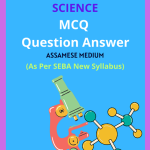Class 7 Science MCQ Chapter 13 Motion and Time Solutions in English Medium, Class 7 Science Multiple Choice Question Answer in English to each chapter is provided in the list so that you can easily browse throughout different chapters Class 7 Science MCQ Chapter 13 Motion and Time Notes and select need one.
Class 7 Science MCQ Chapter 13 Motion and Time
Also, you can read the SCERT book online in these sections Class 7 Science Objective Type Solutions by Expert Teachers as per SCERT (CBSE) Book guidelines. These solutions are part of SCERT All Subject Solutions. Here we have given Assam Class 7 Science MCQs Solutions in English for All Subject, You can practice these here.
Motion and Time
Chapter – 13
| MCQ |
1. Which of the following is based on the study of the shadow cast by the sun?
(a) Simple pendulum.
(b) Atomic clock .
(c) Sun dial.
(d) Quartz clocks.
Ans: (c) Sun dial.
2. What is the basic unit of speed?
(a) Kilogram per metre.
(b) Metre per second.
(c) Kilometre per hour.
(d) Second per metre.
Ans: (b) Metre per second.
3. Which of the following is the SI unit of time?
(a) Second.
(b) Kilometer.
(c) Meter.
(d) Gram.
Ans: (a) Second.
4. How can we determine which of two objects is moving faster?
(a) By measuring their weight.
(b) By comparing their speeds.
(c) By measuring their temperatures.
(d) By comparing their distances.
Ans: (b) By comparing their speeds.
5. The most appropriate unit for expressing the speed of a space rocket is:
(a) m/s.
(b) km/h.
(c) km/s.
(d) km/min.
Ans: (b) km/s.
6. What is used for the measurement of time in periodic events?
(a) Speedometer.
(b) Thermometer.
(c) Pendulum motion.
(d) Barometer.
Ans: (c) Pendulum motion.
7. The instrument installed in a car for measuring the distance travelled by the car is called:
(a) Barometer.
(b) Speedometer.
(c) Anemometer.
(d) Odometer.
Ans: (d) Odometer.
8. What does a distance-time graph for an object moving with constant speed look like?
(a) A curved line.
(b) A zigzag line.
(c) A straight line.
(d) A wavy line.
Ans: (c) A straight line.
9. The slope of a distance time graph of a moving object indicates:
(a) Distance moved by the object
(b) Time taken by the object
(c) Speed of the object
(d) Position of the object.
Ans: (c) Speed of the object.
10. How is the speed of an object calculated?
(a) Distance divided by weight.
(b) Time divided by distance.
(c) Distance divided by time.
(d) Time divided by weight.
Ans: (c) Distance divided by time
11. Which of the following is the most appropriate to demonstrate the runs scored in the various overs of a cricket match?
(a) Time graph.
(b) Bar graph.
(c) Pie chart.
(d) Line graph.
Ans: (b) Bar graph.
12. A horse pulling a cart has:
(a) Oscillatory motion.
(b) Circular motion.
(c) Linear motion.
(d) None of these.
Ans: (a) Oscillatory motion.
13. The clocks and watches which are used for measuring time are based on:
(a) Rectilinear motion.
(b) Circular motion.
(c) Periodic motion.
(d) Rotational motion.
Ans: (c) Periodic motion.
14. A car moves with a speed of 80 km/h for 15 minutes and then with a speed of 60 km/h for the next 15 minutes. The total distance covered by the car is:
(a) 100km.
(b) 50km.
(c) 35 km.
(d) 70km.
Ans: (c) 35 km
15. The distance-time graph of a car which comes to a stop after covering a certain distance will be:
(a) A straight line sloping upwards.
(b) A curved line sloping downwards.
(c) A straight line parallel to time.
(d) A straight line parallel to distance axis.
Ans: (c) A straight line parallel to time axis.

Hi! my Name is Parimal Roy. I have completed my Bachelor’s degree in Philosophy (B.A.) from Silapathar General College. Currently, I am working as an HR Manager at Dev Library. It is a website that provides study materials for students from Class 3 to 12, including SCERT and NCERT notes. It also offers resources for BA, B.Com, B.Sc, and Computer Science, along with postgraduate notes. Besides study materials, the website has novels, eBooks, health and finance articles, biographies, quotes, and more.



